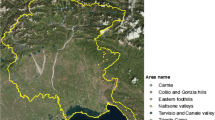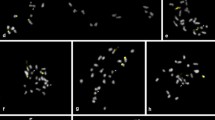Abstract
Despite the economic and cultural importance of the indigenous “Amerindian” yam Dioscorea trifida, very little is known about their origin, phylogeny, diversity and genetics. Consequently, conventional breeding efforts for the selection of D. trifida genotypes resistant to potyviruses which are directly involved in the regression of this species have been seriously limited. Our objective of this paper is to contribute to the clarification of the cytogenetic status, i.e., inheritance and chromosome number. Our results provide genetic evidence supporting tetrasomic behaviour of the genome of D. trifida based on chromosomal segregation pattern analysis using eight SSRs markers in three different crosses. This is the first reliable evidence of an autopolyploid species in the genus Dioscorea. The second major result in this study is the revealing of a new base chromosome number in the botanical section Macrogynodium to which D. trifida belongs. To date, our assumptions about the ploidy level of yams are based on the observations that the basic chromosome number is 10 or 9, and D. trifida was described as octoploid. The chromosome number of D. trifida accessions was also assessed using somatic chromosomic count techniques. Flow cytometry did not show significant variation of 2C DNA content among 80 accessions indicating homogeneity of the ploidy level of the cultivated D. trifida. This suggests that autotetraploidy is well established as well as the rule for the cultivated pool of D. trifida, even if the direct diploid ancestor remains to be identified. The data presented in this paper are significant and important for the effective breeding and conservation of the species and for elucidating the phylogeny and the origins of the yam and the evolution of the genus Dioscorea.

Similar content being viewed by others
References
Abraham KA (1998) Occurrence of hexaploid males in Dioscorea alata L. Euphytica 99:5–7
Abraham KA, Nair PG (1990) Vegetative and pseudogamous parthenocarpy in Dioscorea alata. J Root Crops 16:58–60
Allendorf FW, Danzmann RG (1997) Secondary tetrasomic segregation of MDH-Band preferential pairing of homeologues in Rainbow Trout. Genetics 145:1083–1092
Ayensu ES, Coursey DG (1972) Guinea yams. The botany, ethnobotany, use and possible future of yams in West Africa. Econ Bot 26:301–318
Bai KV, Jos JS, Hrishi N (1978) Polyploidy in the variety spinosa of D. esculenta. J Root Crops 4:11–14
Baquar SR (1980) Chromosome behaviour in Nigerian yams (Dioscorea). Genetica 54:1–9
Bever JD, Felber F (1992) The theoretical population genetics of autopolyploidy. Ox Surv Evol Biol 8:185–217
Bousalem M, Douzery EJ, Fargette D (2000) High genetic diversity, distant phylogenetic relationships and intraspecies recombination events among natural populations of Yam mosaic virus: a contribution to understanding potyvirus evolution. J Gen Virol 81:243–255
Bousalem M, Dallot S, Fuji S, Natsuaki KT (2003) Origin, world-wide dispersion, bio-geographical diversification, radiation and recombination: an evolutionary history of Yam mild mosaic virus (YMMV). Infect Genet Evol 3:189–206
Burkill IH (1960) The organography and the evolution of the Dioscoreaceae, the family of the yams. J Linn Soc (Bot) Lond 56:319–412
Caddick LR, Wilkin P, Rudall PJ, Chase MW, Hedderson TAJ (2002) A formal revised classification of Dioscoreales. Taxon 51:103–114
Coursey DG (1967) Yams. Longmans Green, London, pp 28–67
Degras L (1993) The yam. A tropical root crop. In: Coste R (ed) Macmillan/CTA, London and Basingstoke, 408 pp
Demarly Y (1958) Contribution à l’étude des tétraploides. Ann Génét 34:25–39
Dolezel J, Binarova P, Lucretti S (1989) Analysis of nuclear DNA content in plant cells by flow cytometry. Biol Plant 31:113–120
Essad S (1984) Variation géographique des nombres chromosomiques de base et polyploïdie dans le genre Dioscorea à propos du dénombrement des espèces transversa Brown, pilosiuscula Bert et trifida. Agronomie 4:611–617
Fjellstrom RG, Beuselinck PR, Steiner JJ (2001) RFLP marker analysis supports tetrasomic inheritance in Lotus corniculatus L. Theor Appl Genet 102:718–725
Henry VCR (1967) Studies on botanical and agronomic characteristics in cush-cush (Dioscorea trifida L). Thesis, Anonymous McGill University Montreal, Canada
Hochu I, Santoni S, Bousalem M (2006) Isolation, characterization and cross-species amplification of microsatellite DNA loci in the tropical American yam Dioscorea trifida. Mol Ecol Notes 6:137–140
Jackson RC, Casey J (1982) Cytogenetic analysis of autopolyploids: models and methods for triploids to octoploids. Am J Bot 69:487–501
Jannoo N, Grivet L, David J, D’Hont A, Glaszmann JC (2004) Differential chromosome pairing affinities at meiosis in polyploid sugarcane revealed by molecular markers. Heredity 93(5):460–467
Jos JS, Bai KV, Hrishi N (1976) Polarity of metaphase plate in Dioscorea hispida Dennst. Curr Sci 45:770–771
Knuth R (1924) Dioscoreaceae. Pflanzenreich 87(IV, 43):1–278
Krebs SL, Hancock JF (1989) Tetrasomic inheritance of isoenzyme markers in the highbush bluebeny, Vaccinium colymbesum L. Heredity 63:11–18
Martin FW, Degras L (1978) Tropical yams and their potential. Part 6 Minor cultivated Dioscorea species. Agricultural handbook no 538. Anonymous Science and Education Administration, US Department of Agriculture (USDA) and USAID, Washington, 23 pp
Martin FW, Ortiz S (1963) Chromosome numbers and behaviour in some species of Dioscorea. Cytologia 28:96–101
Mignouna HD, Mank RA, Ellis THN, van den Bosch N, Asiedu R, Ng SYC, Peleman P (2002a) A genetic linkage map of Guinea yam (Dioscorea rotundataPoir) based on AFLP markers. Theor Appl Genet 105:716–725
Mignouna HD, Mank RA, Ellis THN, van den Bosch N, Asiedu R, Ng SYC, Peleman P (2002b) A genetic linkage map of water yam (Dioscorea alata L.) based on AFLP markers and QTL analysis for anthracnose resistance. Theor Appl Genet 105:726–735
Olson MS (1997) Bayesian procedures for discriminating among hypotheses with discrete distributions: inheritance in the tetraploid Astilbe biternub. Genetics 147:1933–1942
Qu L, Hancock JF (1995) Nature of 2n gamete formation and mode of inheritance in interspecific hybrids of diploid Vaccinium darrowii and tetraploid V. corymbosum. Theor Appl Genet 91:1309–1315
Raghavan SR (1958) A chromosome survey of Indian Dioscorea. Proc Indian Acad Sci Sec B 48:59–63
Raghavan SR (1959) A note on some South Indian species of the genus Dioscorea. Curr Sci 28:337–338
Ramachandran K (1968) Cytological studies in Dioscorea. Cytologia 33:401–410
Scarcelli N, Daïnou O, Agbangla C, Tostain S, Pham JL (2005) Segregation patterns of isozyme loci and microsatellite markers show the diploidy of African yam Dioscorea rotundata (2n = 40). Theor Appl Genet 111:226–232
Segarra-Moragues JG, Catalán P (2003) Life history variation between species of the relictual genus Borderea(Dioscoreaceae): phylogeography, genetic diversity, and population genetic structure assessed by RAPD markers. Biol J Linn Soc 80:483–498
Segarra-Moragues JG, Palop-Esteban M, Gonza’Lez-Candelas F, Catalán P (2004) Characterization of seven (CTT)n microsatellite loci in the Pyrenean Endemic Borderea pyrenaica (Dioscoreaceae): remarks on ploidy level and hybrid origin assessed through allozymes and microsatellite analyses. J Hered 95:177–183
Sharma AK, De DN (1956) Polyploidy in Dioscorea. Genetica 28:112–120
Shiotani, I, Kawase T (1989) Genomic structure of sweet potato and hexaploids in Ipomoea trifida(HBK) Don. Jpn J Breed 39:57–66
Soltis DE, Riesberg LH (1986) Autopolyploidy in Tolmiea mziesii (Saxifragaceae): genetic insights from enzyme electrophoresis. Am J Bot 73:310–318
Soltis DE, Soltis PS (1993) Molecular data and the dynamic nature of polyploidy. Crit Rev Plant Sci 12:243–273
Soltis DE, Soltis PS (1999) Polyploidy: recurrent formation and genome evolution. Trends Ecol Evol 14: 348–352
Soltis DE, Soltis PS, Jennifer A, Tate JA (2003) Advances in the study of polyploidy since plant speciation. New Phytol 161:173–191
Soltis DE, Soltis PS, Pires JC, Kovarik A, Tate JA, Mavrodiev E (2004) Recent and recurrent polyploidy in Tragopogon (Asteraceae): cytogenetic, genomic and genetic comparisons. Biol J Linn Soc 82:485–501
Stebbins GL (1950) Variation and evolution in plants. Columbia University Press, New York, 643 pp
Sybenga J (1969) Allopolyploidization of autopolyploids. I. Possibilities and limitations. Euphytica 18:252–260
Terauchi R, Konuma A (1994) Microsatellite polymorphism in Dioscorea tokoro, a wild yam species. Genome 37:794–801
Thompson JD, Lumaret R (1992) The evolutionary dynamics of polyploid plants: origins, establishment and persistence. Trends Ecol Evol 7:302–307
Tostain S, Scarcelli N, Brottier P, Marchand JL, Pham JL, Noyer JL (2006) Development of DNA microsatellite markers in tropical yam (Dioscorea sp.). Mol Ecol Notes 6:173. DOI 10.1111/j.1471-8286.2005.01182.x
Watson LE, Elisens WJ, Estes JR (1991) Electrophoretic and cytogenetic evidence for allopolyploid origin of Manhullia mohrii (Asteraceae). Am J Bot 78:408–416
Zoundjihekpon J, Essad S, Tio-Touré B (1990) Dénombrement chromosomique dans dix groupes variétaux du complexe Dioscorea cayenensis–rotundata. Cytologia 55:115–120
Zoundjihekpon J, Hamon S, Tio-Touré B, Hamon P (1994) First controlled progenies checked by isozymic markers in cultivated yamsDioscorea cayenensis–rotundata. Theor Appl Genet 88:1011–1016
Acknowledgements
We thank the Institut National de la recherche Agronomique (INRA) for financial support of this project. The authors wish to thank Dr. T. Timbarger and the two anonymous referees for their critical review of the manuscript and valuable suggestions. J. Ronfort’help was also greatly appreciated in the segregation analysis. Thanks are also due to the Chambre d’Agriculture de Guyane and the Mission pour la Création du Parc de la Guyane who provided support staff for the collecting mission. The authors gratefully acknowledge the assistance of J.L. Pham, S. Tostain, D. Aribi for their assistance in the D. trifida germplasm management at the Institut de Recherche pour le Développement (IRD), Montpellier.
Author information
Authors and Affiliations
Corresponding author
Additional information
Communicated by B. Friebe
Rights and permissions
About this article
Cite this article
Bousalem, M., Arnau, G., Hochu, I. et al. Microsatellite segregation analysis and cytogenetic evidence for tetrasomic inheritance in the American yam Dioscorea trifida and a new basic chromosome number in the Dioscoreae . Theor Appl Genet 113, 439–451 (2006). https://doi.org/10.1007/s00122-006-0309-z
Received:
Accepted:
Published:
Issue Date:
DOI: https://doi.org/10.1007/s00122-006-0309-z




